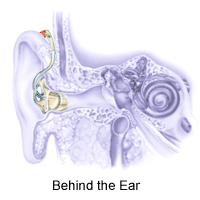Hearing Loss
Broadly speaking, hearing loss is classified as Conductive hearing loss, Sensorineural hearing loss or Mixed hearing loss.
Conductive Loss
Conductive hearing loss is caused by the obstruction of sound being transferred to the inner ear. This could be due to wax (cerumen) blocking the pathway of sound or problems in the middle ear such as middle ear infections or tympanic membrane perforations (hole in the ear drum). Most conductive hearing losses can be reversed or corrected by medical intervention.
Senorineural Loss
This form of hearing loss is caused by damage to the hair cells in the cochlea (inner ear). Damaged hair cells send out weaker electro-chemical signals to the brain, which in turn gets less information. The majority of hearing losses fall into this category. This type of hearing loss is non-reversible.
Mixed Loss
This type of hearing loss is a combination of conductive and sensorineural hearing loss. The severity of the hearing loss depends on the involvement of the conductive and sensorineural components of the hearing mechanism.
Neural loss
This type of hearing loss is due to problems in the auditory neural pathway (ie. The auditory nerve) which conducts sound to the brain.
All types of hearing loss can be treated with hearing aids, auditory implants, cochlear implants or brain stem implants depending on the nature and the degree of hearing loss.
Private Health Fund Rebates and Tax Offsets

Hearing aids may be covered by your private health fund. Please check with your own private health fund if you are eligible for a rebate as each fund varies according to amounts, conditions and rules that can affect your entitlements.
Tax offsets can also be obtained from the Australian Taxation office as hearing aids come under the "medical expenses tax offset". Further advice can be obtained by phoning the Personal Tax Infoline on 132 861 or on 1800 806 215 (TTY)

